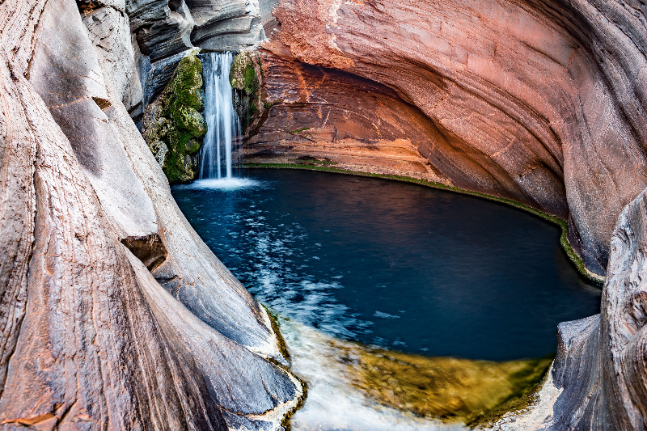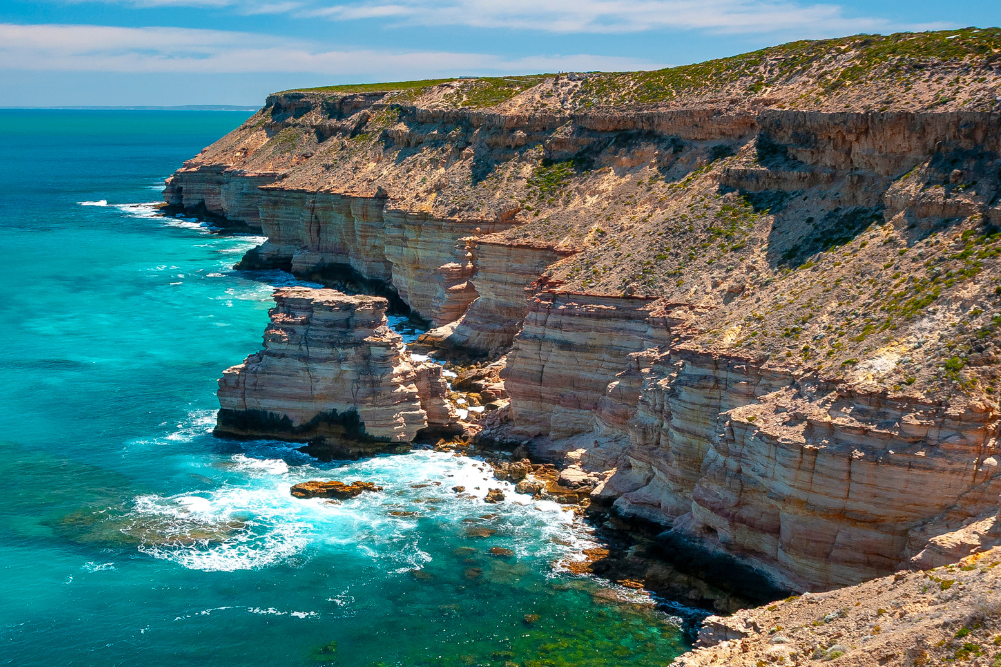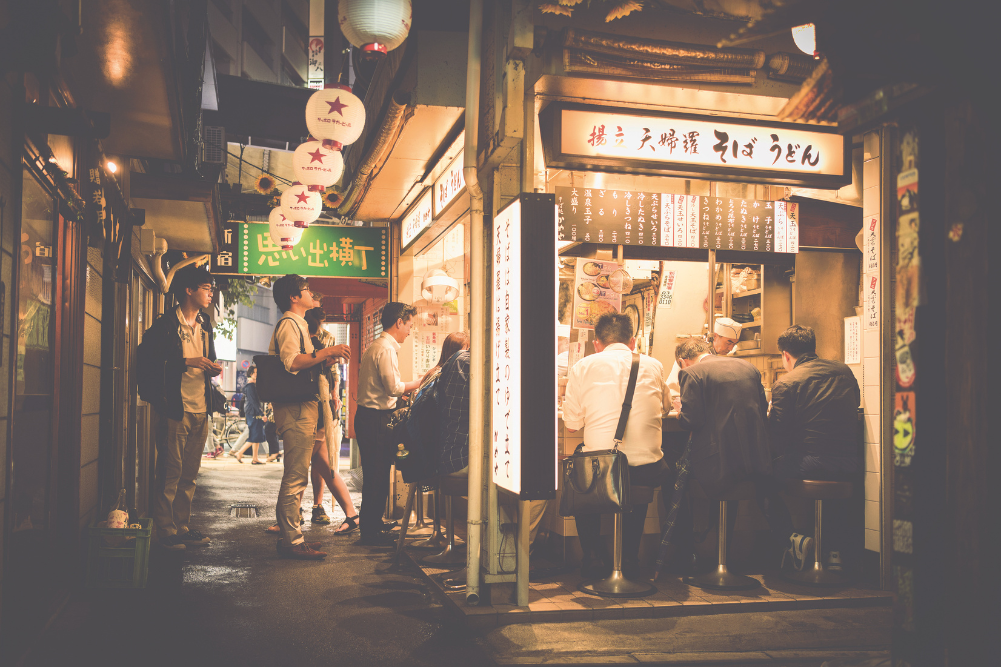Explore Karijini National Park
Great purple spears of mulla mulla bloom on the parched Pilbara plains, colouring a thirsty spinifex landscape that rises to the Hamersley high plateau. Here, far from the ocean and surrounded by a sea of red dirt, I peer into Dales Gorge, standing on the edge of a gaping abyss that drops suddenly and swiftly away to fern-fringed Circular Pool far below.
I’m in Karijini National Park: a massive system of rugged rock chasms and twisting waterways, girthed by lucrative ironstone hills that support a multi-billion-dollar mining scene. Incongruous as those distant quarried hills may be, Karijini’s sacred and significant rock sanctuary shines as one of the most alluring destinations in the west.
Over the cool winter months, the park attracts record crowds who rough it along razor-sharp access roads, armed with hiking boots and hats to explore the trails that shimmy and drop into seven gorges and lead to vertigo-inducing lookouts where you can watch the sun begin and end its passage across the Hamersley Range.
Sombre trailhead warnings about fitness and experience surely deter some travellers … but seem only to inspire the thrill-seekers, luring them down steel ladders and along a swiftly flowing “trail” to the Amphitheatre.
There’s a lot to explore in a national park that covers 627,422 hectares and rates as Western Australia’s second largest, from thrilling off-trail adventures to short waterfall trails that end at deep, chilly swimming pools. While most travellers arrive with their own beds on board, bound for the national park-run Dales Campground above Fortescue Falls, Karijini Eco Retreat saves non-camping types with luxurious safari tents, restaurant meals and a breezy sunset bar.
When it comes to exploring, though, Karijini’s rugged landscape is a great leveller, turning travellers into bushwalkers and rewarding with incredible sculpted scenes. Images of the park’s unconventional, rock-hopping trails might have you thinking Karijini reserves its thrills for experienced, hardy walkers. Surprisingly, there are all kinds of ways to enjoy this destination and visitors will quickly discover that some of the best vistas are within easy reach.
The Spider Walk
With our legs braced between two slippery rock walls, we shimmy along the Spider Walk, splash through a shallow pool and pause at a deep, narrow, water-filled chasm that swallows the path ahead. With a daypack and a toddler in tow, a swim is out of the question, so we tackle an alternative high route along slender rock ledges that my plucky three-year-old manages with heart-stopping ease.
Soon we are standing on the edge of the bright green, seemingly bottomless Kermit’s Pool. A dreadlocked backpacker suddenly takes the plunge from a lofty ledge, disappearing beneath the surface and out of sight. He returns to us beaming, his adrenalin palpable, and we all find a cool, water-smoothed spot to take in our peculiar surroundings deep inside Hancock Gorge.
Requiring more wading than walking, this thrilling Class 5 adventure sets out from Weano Recreation Area for what park brochures call the “Centre of the Earth”. Sombre trailhead warnings about fitness and experience surely deter some travellers from tackling this amazing three-hour-long endeavour, but seem only to inspire the thrill-seekers, luring them down steel ladders and along a swiftly flowing “trail” to the Amphitheatre, a small stone arena where a pretty waterfall flows.
We climb down into the gorge, rock-hopping along ledges to reach a jade-coloured waterhole surrounded by a sunken garden of maidenhair ferns and fig trees that plant their roots among iron boulders.
Further downstream, the Spider Walk is perhaps the most challenging part of this stimulating obstacle trail, best tackled in bare feet with legs braced against the highly polished rock. Beyond here, you need only work up the courage to jump into Kermit’s Pool, as lurid as it is deep.
Undoubtedly one of Karijini’s favourite adventures, Hancock Gorge is rivalled only by a meander into nearby Weano Gorge, which challenges us with an invigorating wet walk. The unexpected lack of track sharpens my focus as I search constantly for foot holes, removing shoes to connect, quite literally, with the rock. When I finally find my rhythm, I become as alert and balanced as my naturally springy child, bounding effortlessly ahead.
The trail finally squeezes through a slender rock chasm and we follow the short waterfall over the edge into Handrail Pool, surrounded by warming rock slabs where we laze and bake, staring up at a tiny wedge of blue sky high above.
Waterfalls & pools
If slipping and sliding and stressing your adrenal glands is not your style, the walk through Dales Gorge might be, connecting two exceptional swimming holes sculpted beneath a sheer-drop falls at one end and a gentle, palm-fringed cascade at the other.
Following a trickling creekbed towards the head of Dales Gorge, we watch it suddenly disappear, plunging into a void 100 metres deep and gathering again as Circular Pool far below. Chasing this deep, cool oasis, we climb down into the gorge, rock-hopping along ledges to reach a jade-coloured waterhole surrounded by a sunken garden of maidenhair ferns and fig trees that plant their roots among iron boulders.
Springwater seeping through horizontal rock layers joins the creek’s modest winter flow, feeding the scene, and spindly paperbarks throw shade as we lounge on boulders in between chilly dips. When we finally manage to tear ourselves away, we pack up our picnic and follow Dales Creek downstream beneath sheer stacks of fractured red rock to Fortescue Falls.
Time stops as we bathe beneath Fortescue Falls, lazing in whitewater that scenically cascades over two tiers of weathered rock terraces. Stalled by the thought of tackling the uphill retreat to camp, we climb around the falls and spend time in Fern Pool, too: a deep, clear plunge pool favoured by flying foxes. The day drifts away and the sun clears the horizon before we make a move, finally ascending to the gorge rim and dragging our weary bodies back to camp.
Overnighting in style
For self-sufficient travellers with camping gear or beds on board, the national park’s bush campground at Dales Gorge provides a cheap stay with basic facilities. There are toilets, free gas barbecues and sheltered picnic tables and, if you need them, hot showers and supplies of untreated drinking water a short drive away at the park visitor centre.
Roughing it doesn’t deter the travellers who flock to the camp during the May-to-September peak season, but you can end the day in comfier surrounds at Karijini Eco Retreat. This Indigenous-owned resort provides the only other facilities within the national park and offers a good range of accommodation options, a perfect sunset bar and a restaurant that serves an inspired menu despite its remote location, with gluten-free and vegetarian choices available.
Securing one of the resort’s tempting Deluxe Eco Tents costs AU$229–AU$349, depending on the season, while budget choices include shared safari tents and campsites from AU$20 per person. One of the big advantages of staying at Karijini Eco Retreat is its location in the west of the park, where the incredibly scenic Oxer and Junction Pool Lookouts are easily accessed at sunrise and set.
For wheelchair and stroller accessibility, you can’t beat the easy, sealed path that leads to Junction Pool Lookout and the neck-craning vista of Junction Pool, 100m below. This is also the perfect spot to relax your leg muscles and enjoy something bubbly as the sun goes down. If there’s still fuel in the tank, walk on to Oxer Lookout where four flaring red rock gorges meet: Weano, Hancock, Red and Joffre (800m/30mins return).
Following the sun
A much-photographed destination in the park’s far northwest, Hamersley Gorge is startling at day’s end when the setting sun ignites its striped vibrant rock walls, buckled into beautifully coloured contortions. The waterfall and swimming hole provide a pretty place to cool off while, upstream, rock-hoppers can discover Spa Pool and The Grotto, a magical, fern-fringed chasm tucked into the left-hand side of the gorge.
You’ll need to get up early to beat the sun rising over Mount Bruce, but the morning really is the best time to enjoy this remarkable summit climb. In a state not known for its great mountain peaks, Mount Bruce or Punurrunha offers some rare altitude, and at 1235m it’s WA’s second highest.
Following a ridge up the mountain’s western flanks, there are strangely contrasting views of the magnificent Hamersley Range on one side and the open-cut Marandoo iron mine on the other, and awesome panoramas at the windy summit. As you climb, honey hakeas (cork trees), mulga and spinifex give way to Antarctic pines and wattles, and you might just spot the piles of tiny stones that mark the elaborate subterranean Home of the Pilbara’s tiny pebble mound mouse.
Some sections of the rugged route up Mount Bruce are a little airy, but chains are provided where climbing is required. You don’t have to reach the summit to enjoy this trail, especially after early winter rains when purple mulla mullas, yellow flowering sennas (cassias) and bright northern bluebells carpet the slopes.
Finding solitude
Karijini’s two lesser-visited chasms deserve a mention, simply because you stand a good chance of enjoying their remarkable rock scenery in solitude. A short scramble over Kalamina Gorge’s rocky, spinifex-covered edge lands you in the park’s most easily accessed swimming spot.
Bathing in these shallow rock pools, surrounded by steep rock walls fractured into towering stacks of weathered red tiles, is a lovely way to observe the birds that flit through the mist, feeding on insects at the water’s edge. Downstream in Kalamina Gorge, walkers crisscross shallow pools and skirt fallen boulders to reach Rock Arch pool, a window in the rock that marks the turn-around point (3km/3hrs return).
Scramble down a rugged talus slope sandwiched between soaring, sheer walls and you’re in Knox Gorge where paperbark trees bent horizontal by the water’s turbulent wet season flow dip their feet into rather tempting clear pools. There’s no walking trail here, leaving you free to find your way along smooth river slabs, switching from one bank to the other or simply wading through the flow.
Knox’s swift-flowing stream fills deep pools, forcing you to swim right through or climb high to shimmy along narrow rock ledges, before finally reaching a breathtakingly steep descent where the gorge walls close in to just a few feet. It takes just 30 minutes to reach this point from the trailhead, 1km away, but allow extra time to float in the tranquil pools and absorb the energy that resonates off the rock.
Time your trip
Located just north of the Tropic of Capricorn in tropical semi-desert, Karijini National Park is hot, wet and often inaccessible during summer when dramatic waterfalls are swelled by cyclones and thunderstorms.
Winter’s warm, clear days are perfect for exploring and the wildflowers that bloom after winter showers colour the landscape in brilliant hues.








